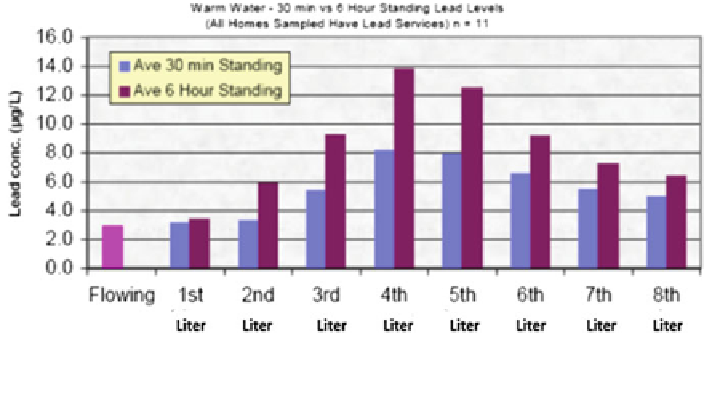Environmental Engineering Reference
In-Depth Information
Fig. 10.3 Lead concentration by volume of water drawn for 11 houses in Ottawa (Campbell and
Douglas
2008
)
understanding of the water chemistry in a distribution area. They concluded that
while the current lead sampling protocol (for Ontario) provided a good initial
indicator of the typical lead exposure patterns for a given distribution area, addi-
tional testing such as analyzing lead concentrations up to the 8th liter can be more
useful in detecting locations which are at risk to potentially high lead exposure.
10.6 Conclusion
We can summarize the main
findings as follows:
(1) The health effects associated with lead in drinking water are well documented
and even at very low-lead levels can cause severe harm to cognitive and intellectual
development in young children; (2) Adults are also susceptible to harmful effects
from lead, e.g. studies have shown lead can affect kidney function as well as the
reproductive system; (3) No threshold effects have been reported for BLLs; (4) The
costs associated with BLLs can be quite high. Estimates from Davies (
2006
) put the
cost for lead poisoning for a 1-year cohort of 5-year olds in Washington State at
$1478.8 million in 2004 dollars while Landrigan et al. (
2002
) show a cost of $43.4
billion for a cohort of 5-year olds; (5) Other studies have shown reduced IQ and
lower worker productivity; (6) Lead sampling protocols are important in assessing
the risk posed from lead in drinking water. Inadequate sampling protocols can result
in huge economic losses as stated above; (7) The Ontario sampling protocol used in
determining lead in drinking water is heavily based on the EU Report while the new
Canadian Federal Guidelines follow the EPA protocol closely; (8) The EU Report
recommends either the RDT or 30MS as protocols, which can be used to assess lead
levels within a distribution system. However, the Report is faulty in terms of

Search WWH ::

Custom Search